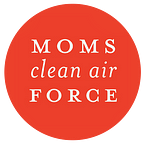Wildfire Smoke and Your Health
Children, the elderly, and people with heart disease, lung disease, and asthma are especially vulnerable to health problems caused by wildfire smoke.
Wildfires affect not only people in the immediate area, but they also send vast amounts of dangerous pollution into communities near and far, in the form of smoke.
Smoke is made up of ash, tiny particles, liquid droplets, and gases. It also contains toxic chemicals released from burning flame retardants in furniture and fabrics, and other chemicals in building materials.
The most concerning pollutant is particle pollution, or PM2.5 — a dangerous air pollutant that also comes from car and truck tailpipes, power plants, and factories.
Particle pollution is so small you can’t see it. Each individual bit of solid or liquid in PM2.5 is less than 2.5 microns in diameter-smaller than one twentieth the width of a human hair. These tiny particles have a unique ability to penetrate deep inside the lungs, into the broccoli-shaped alveolar sacs. They can lodge there or slip directly into the bloodstream.
Wildfire smoke is hazardous to your health. Smoke inhalation can kill. Other health effects include chest tightness; shortness of breath; wheezing; coughing; burning sensation in respiratory tract and eye; chest pain; dizziness or lightheadedness; nausea; asthma attacks; reduced lung function; bronchitis; and exacerbation of preexisting conditions, such as heart disease.
Wildfire smoke can contain toxic air pollutants such as polycyclic aromatic hydrocarbons (PAHs), benzene, and formaldehyde. However, short-term exposure to these carcinogens, such as in a wildfire, are small relative to overall lifetime exposures and are not likely to significantly increase risk of cancer.
The danger from wildfires doesn’t end when the fires are doused. Wildfire smoke lingers and spreads, causing major health problems. Cleaning up from fires also exposes people to potentially hazardous conditions, such as heavy metals in ash and dust, and risk of injury from unstable buildings and debris.
Adult lungs can recover fully from some smoke damage. Cardiovascular impacts from wildfire smoke, such as increased risk of blood clots, heart attack, and stroke, also appear to be temporary.
Wildfires across the country, and especially in the West, are burning more intensely than ever before. Across the Western U.S., the average annual number of large fires each year has more than tripled since the 1970s. Wildfire seasons are also lasting longer than they used to, up to 105 days longer than in the 1970s, straining the fire-fighting budgets of many states. When fires burn, health care costs balloon as well.
People in the new Smoke Belt-Northern California, Western Oregon, and the Great Plains-are at greatest risk of exposure to wildfire smoke.
Climate change is making wildfires worse. Our warming temperatures contribute to both the intensity and length of many wildfires — and this trend is projected to increase.
PLAN AHEAD FOR SMOKE WAVES
Smoke waves occur when there are more than two consecutive days of high levels of wildfire-related air pollution. Prepare well in advance for smoke waves; supplies can be scarce during a crisis.
If you live in or near an area that is prone to wildfires, buy a box of face masks that can protect you from the smoke. Keep it with your emergency supplies so you can grab it if you have to leave home in a hurry.
Choose a N95 or N100, NIOSH-approved face mask-with two straps — to get protection from fine particles.These masks are available at drugstores, hardware stores, and online.
Children breathe faster than adults, so they will be hit harder by wildfire smoke. Unfortunately the effective masks are not manufactured to seal around small faces.
Do NOT rely on surgical masks or dust masks. They will not work for wildfire smoke.
Do NOT rely on single strap masks. They will not make a tight enough seal.
Do NOT rely on wet bandanas or towels. They won’t protect you from inhaling tiny particles.
Know the warning signs of smoke inhalation. Early signs of trouble include wheezing, stinging in eyeballs and throat, a feeling of mucous membrane “burn,” chest tightness, and a chronic need to cough.
Identify buildings in your area (such as schools or libraries or government centers) that have installed sophisticated air filtration systems.
Pay attention to evacuation notices. Consider relocating to stay with relatives or friends who live away from the smoke during fires.
PROTECT YOUR FAMILY FROM WILDFIRE SMOKE
Stay indoors, with doors and windows closed.
Avoid strenuous activity and exercise.
If possible, run an air-conditioner on the “recirculate” setting. Maintain your air conditioner by changing the filter when recommended.
Reduce other sources of indoor air pollution, such as smoking, wood stoves, wood fires, candles, incense, frying and broiling food, and vacuuming, all of which can generate particle pollution.
High-efficiency particulate air (HEPA) filter air cleaners can help reduce indoor particle levels, but the specific air cleaner needs to be matched to the size of the room. Only portable air cleaners that do not produce excess ozone should be used.
Never operate gasoline-powered generators indoors. They produce dangerous carbon monoxide.
When riding in a car, keep the windows and vents closed. Run air-conditioning on “recirculate.”
Originally published at https://www.momscleanairforce.org.
